
How to clarify human futures beyond Earthby Joe Carroll
|
| Our only data on the effects of sustained gravity on health are: 1g = good; 0g = poor. |
These clusters have practical implications. Four other planets have within 12% of Earth gravity. But all four have extreme temperatures and atmospheric pressures. And all but Venus have two to three times Earth’s escape velocity. Returning to Earth would be hard.
The eight smaller bodies near Moon or Mars gravity seem more practical. They also have much lower two-way delta-Vs. So, a key question for living beyond Earth is whether lunar or at least Martin gravity will let us avoid health problems like those we have seen in sustained free fall. But we have no health data between 0g and a full 1g!
We tend to ignore how much gravity humans may need to stay healthy. The reason is simple: no data. But we have learned one critical fact about human health: the longer that people stay in free fall, the more significant health issues we find.
Early in the space age, most planners assumed rotating crewed facilities to provide Earth-level artificial gravity. Apollo flights were planned to last only 6 to 12 days, so interest in artificial gravity faded after the Gemini 7 crew spent 14 days in free fall. Even 4-, 8-, and 12-week crew stays on Skylab caused few health issues. But crews who spent 6 to 12 months on Salyut, Mir, or ISS have had significant degradation of their bones, muscles, fluids, eyes, brain, and immune response. [2,3,4,5,6] Exercise, diet, and drug “microgravity countermeasures” have slowed these trends but have not stopped them, despite decades of countermeasure refinements. [7,8]
The most important health countermeasure for microgravity seems to be sustained vigorous exercise. On ISS, two hours a day is typical. Even on Earth most adults do not get enough exercise for good health. Sustained health in much lower gravity may require vigorous exercise times near ISS levels. And people may still need many of the diet and drug countermeasures now used on ISS. NASA’s Artemis exploration plan limits crew lunar stays to 30-45 days. [9] ISS health data suggests that 45 days is too far short for us to learn whether or how humans might live on the Moon. And refining countermeasures may require many long iterations to evaluate health.
NASA is focused on crew exploration development and is just now estimating mission costs. There may not be enough support for those missions if they cannot tell us whether lunar or Martian gravity are enough for humans to live in health there.
An alternative is to learn whether, how, and how well we can live in lunar and Martian gravity, by long stays in artificial partial gravity in low Earth orbit (LEO). This can tell us the health effects of living in Moon and Mars gravity and lets us refine any countermeasures. This essay updates concepts from earlier papers [10,11].
The main topics are:
Ground tests in vertical-axis rotating rooms show that a few people get queasy at rotation rates just under two rpm, but most tolerate faster rotation, and most adapt to even higher rates over time. [12] Note that thresholds for noticing yaw rotation are far lower: less than 0.5 rpm. [13] But these tests cause different spin artifacts from artificial gravity, since the spin axis aligns with gravity, rather than at right angles. Rotating room tests cause the same spin-rate artifacts in any direction. This eases adaptation.
In artificial gravity, each time you turn around, the spin direction felt by the inner ear reverses. In addition, centrifugal force and hence weight change significantly, whenever you walk (or even reach) with or against the spin. People often stumble in an elevator if they walk when it starts or stops (typically at ~0.05g). Artificial gravity can cause larger changes. Neither artifact occurs in rotating room tests, so such tests cannot test our reactions to them. Relevant tests require these artifacts.
| To get lunar or Martian gravity with the smallest spin-rate artifacts, we should use the longest affordable radius, not the shortest plausible one. |
These artifacts scale with spin rate. And their felt effects will seem larger in lower gravity. To get good data on the effects of sustained partial gravity (rather than our reactions to spin-rate), we should minimize spin rate artifacts. But getting the same artificial gravity level at half the spin rate requires a radius four times longer: a = ω2r.
To limit facility radius, most artificial gravity facility designers used the fastest spin (usually two to six rpm) that they thought crews would tolerate. [14] But none ever flew, so we don’t know how they would have worked. To get lunar or Martian gravity with the smallest spin-rate artifacts, we should use the longest affordable radius, not the shortest plausible one. Suitable designs may allow far lower spins of about 0.5 to 1 rpm.
Figure 2 below shows a sequence of rotating facility shapes. They have gradually larger pressurized volume (and so higher mass and launch cost) at the same radius.
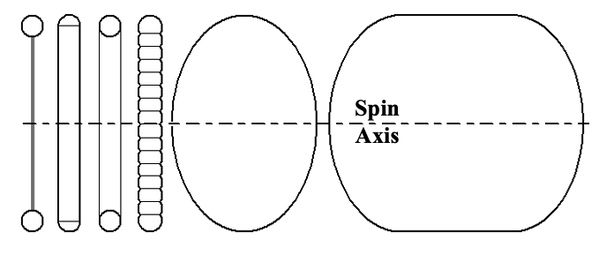 Figure 2. Shapes for spinning artificial gravity facilities |
Figure 1 showed that the best gravity levels to clarify space settlement options are lunar and Martian gravity. The only shapes that can put most of the volume near those levels are a dumbbell with 7:3 mass ratio, or two concentric donuts. But a dumbbell allows a far longer radius for any total mass. That minimizes spin-rate artifacts.
Once a dumbbell starts rotating, most vehicles may dock at a hub on the spin axis. But crew and cargo must be able to pass through the radial structure to get from the hub to the Moon and Mars gravity-test modules. Using an “airbeam” as the radial structure allows such transfers in shirtsleeves. Figure 3 shows a test of an airbeam that supports a military field hospital. [15] Two people can lift and move it (without the car). Figure 4 shows a design for a straight airbeam with eight heavy axial straps and a four-layer debris shield. It can flatten and roll up for launch. After it deploys, the crew can install elevators and utilities, to transfer crew, cargo, fluids, and power.
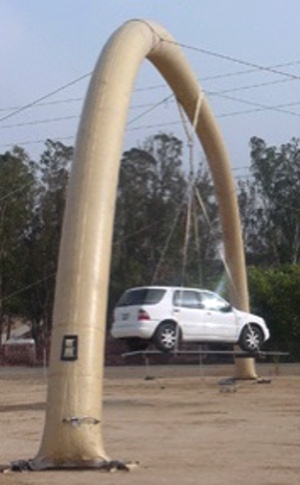 Figure 3. Airbeam test |
Airbeams use Vectran or similar fibers in a tough rubber matrix, like tire sidewalls. An airbeam might serve as the radial structure for a Moon-Mars dumbbell up to at least two kilometers long. That allows spins as low as 0.5 to 1 rpm, at airbeam masses about 5% to 20% of the full dumbbell mass. If a one-rpm Moon-Mars dumbbell needs only ~5% of its total mass for ~460 meters of airbeams, it may not make sense to even consider shorter designs that impose spins greater than 1 rpm on all those who will live in the facility.
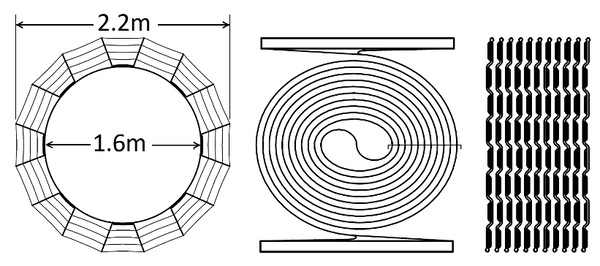 Figure 4. Airbeam cross-sections, deployed and stowed |
Figure 5 shows assembly and deployment of a one-rpm dumbbell. Besides lunar and Martian gravity, it has a hub to allow docking at the spin axis, plus a low-g node. For clarity, debris shields and radiators are not shown.
 Figure 5. Assemble and deploy |
I assume Starship for launch and re-supply. It is still being developed but I think success is likely. Keeping Starship busy will require new markets and customers.
Crews can use Dragon until Starship is crew-rated. Dragons far from the spin axis hang outward, to reduce bending loads. Replacement Dragons can dock at the spin axis. Then “clothesline loops” (not shown) can transfer them to other nodes.
The left view shows a Starship payload being berthed by an ISS-type robot arm. Airbeam segments with 1.6-meter ID (2.2 meters with debris shields) stow inside three modules, and mate with other modules after berthing. During assembly, spin is not needed. A Crew Dragon can launch the initial crew. Body-mount solar arrays can provide initial power, with large battery backup.
The next view includes all six Starship payloads (with three in-line), and two more Crew Dragons. Thrusters at the Mars module can start a very slow spin. This allows release of large hanging solar arrays. They track only around the hang axis. Venting air into an airbeam can break weak tiedowns, so it unwinds in stages.
Thrusters slowly add more spin as the length grows, to maintain enough tension to keep the assembly nearly straight. After the first airbeam section fully deploys, the other two can deploy, in either order.
Pop-out inflatable modules can deploy before or after the airbeam. (All inflatables are shown in light gold.)
The right view is after full deployment. It shows both Starship and Dragon docked at the hub. Dragons dock right on the spin axis. I assume Starship uses a wider docking port, with an approximately three-meter port-to-CG offset.
Each module has water tanks, pumps, and piping, to allow adjustment of dumbbell CG and MOI. Tethers with bridles at each end (not shown) provide some redundancy for the airbeam axial straps, and wider attach footprints to reduce any tilting of the modules.
Eventually, rotating free-space settlements will get massive enough to use other shapes, but dumbbells plus airbeams seem like the key to useful early ones.
As with ISS, a Moon-Mars dumbbell can support a small assembly crew, once one Dragon is attached and solar arrays can provide enough power. Once the dumbbell is fully deployed and tested, it can support far larger crews.
| Which would you prefer to visit: ISS (only in 0g!), or a dumbbell with Mars, Moon, 0.06g, and 0g? |
After deployment but before full outfitting, a dumbbell can safely test higher spin rates and gravity levels. Spinning a “Moon-0.06g-Mars” facility 1.6 times faster gives gravity levels very near Mars, Moon, and Earth. Spinning only 1.25 times faster provides three in-between levels: 0.25, 0.1, and 0.6g. Each spin rate can give complementary data on crew adaptation to different combinations of spin rate and gravity. This data allows better designs for Mars trips, later dumbbells, and early settlements.
The combined drag area of airbeams, solar arrays, radiators, and modules requires substantial reboost at orbits 400 kilometers high, like that of the ISS. High-specific-impulse ion thrusters can do this. In an ISS-like orbit, time in the Sun varies on cycles of one to two months. If the facility spin is near the orbit plane, and the solar arrays track only around their hang axis and can provide enough power (without reboost) when the sun is near the orbit plane, then they can deliver enough extra power for electric reboost over each full cycle. [10]
Most new net mass delivered to the hub may end up at the ends, and some may even be slung outboard from those ends. Such mass outflow requires regular spin-up thrust, to maintain the proper spin rate and artificial gravity level. Pulsed use of fixed ion thrusters at the Mars node can provide any desired combination of reboost and spin-up thrust. Pulsing can also adjust spin phase, to avoid accurately tracked debris. Pumping water between nodes can null out CG offsets before each docking. Pumping can also adjust spin far faster than ion thrusters can.
An initial dumbbell facility might station-keep with ISS but phased far from it. This allows easy crew transfers and joint access to the unique capabilities of each facility. It even lets ISS crews re-accommodate to full Earth gravity in small steps. And most orbital tourists and entrepreneurs may prefer to visit a facility that provides sustained Martian, lunar, and lower gravity as well as free fall, rather than just free fall as on ISS.
Long crew stays may show that some ISS health problems persist even at lunar and Martian gravity. This may lead to far more countermeasure tests, to learn how and how well we might still live on the Moon or Mars. Dumbbells can also test ways to close key supply loops, to make space settlements far more sustainable.
Early tests can be done far better in LEO than on the Moon or Mars. A rotating LEO facility can deorbit sample capsules using tethers less than one kilometer long. SEDS-1 showed in 1993 that tethers can even spin and orient capsules for reentry. [16] Samples might even reach Earth-based labs within about three hours after collection.
Dumbbells need not compete with ISS, which focuses on microgravity effects. Here the goal is to find how to live longer and more sustainably in lunar and Martian gravity.
Developing a rotating crewed LEO facility will eventually involve all “the usual suspects” in most aerospace disciplines, and many other disciplines. Here I discuss just items I think are most likely to cause novel issues, challenges, or opportunities.
Initially, docking can be done along the spin axis. Such operations are often shown in movies, but I know of only actual three captures of rotating objects in orbit. Shuttle crews used EVAs to manually capture Palapa and Westar in 1984, and Intelsat 603 in 1992. Initial attempts all failed, due to unexpected details of the capture targets. But workarounds succeeded. (And some non-spinning captures have also failed.)
Docking to a spinning dumbbell hub might best be done by using a dumbbell spin plane near the orbit plane, but slightly canted so it precesses along with that plane.
| Finding human “gravity prescriptions” in LEO instead of the Moon or Mars allows far faster, cheaper, safer, and more thorough crew testing. |
Visiting vehicles can approach the spin axis at a distance, null errors in position, velocity, and rotation rate and phase, and then close in along the spin axis. But in body coordinates, the in-plane errors vary. Starship has an additional complication of a possible three-meter offset between the crew access port and Starship CM. (The shuttle had about a ten-meter offset from its ISS interface to CM, but never rotated during docking.) Final transitions from soft to hard docking may involve some novel challenges.
Redundant guidance aids and actuators plus reliable software seem needed, for both approach and damping of dynamics. Visiting vehicles also need angled thrusters to minimize thrust and heating on the facility. One could also use a robotic arm to allow berthing, but damping the rotating attitude dynamics will pose challenges.
Eventually, most vehicles may capture a trapeze or loop hanging out from either endmass. [17] This allows capture from lower-perigee orbits. In departing, the line can deploy further. This can passively sling departing vehicles into reentry and also reboost the dumbbell. Each capture-and-deorbit saves each visiting vehicle more than 160 meters per second. These operations also let travelers enter and leave in partial gravity rather than free fall. This seems preferable for spaceflight novices. But each capture or release will briefly shift dumbbell CG and gravity levels, unless capture and departure are paired.
Space stations like Mir and ISS were designed to support on-board lab experiments. There is room to access, use, repair, relocate, stow, and replace most hardware, plus modest living space for six to seven people. A LEO facility designed primarily to sustainably support far more people longer will need far more living space.
The Starship cargo envelope is 685 cubic meters, and its capacity to LEO is more than 100 tons. [18] This is 2.3 times the space shuttle cargo volume, but more than 4.3 times the 23 tons of the heaviest actual shuttle payload.
Inflatable structures allow the usable pressurized facility volume to be far larger than the original launch volume. This may greatly reduce facility launch cost. One can also use erectable enclosures as well as inflatables, but they may require more assembly. Even if all assembly is done by robots, that adds complexity and failure modes, and hence added costs and uncertainties.
Airbeams are in use. [15] Most are less than one meter in diameter. Most airbeam patent claims are for curved shapes. [19] Airbeams for use in space might use some Transhab and Bigelow details, like strong straps to stop tears from grazing impacts. Sustained use in space also requires minimizing gas permeability.
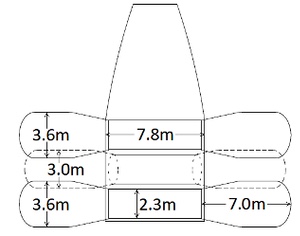 Figure 6. 30 Staterooms |
“Pop-out” inflatables can be installed before launch. Figure 6 shows three floors each with ten inflated radial staterooms. This more than triples Starship payload volume. Room volumes are 58 and 45 cubic meters. The center rooms are clocked between top and bottom ones. Vacuum gaps improve acoustic isolation. Utilities may fit in the rigid central structure. A large multi-layer skirt can drape over the cluster, for debris protection.
A NASA Transhab patent has already expired. [20] Bigelow has others that soon will be. [21] And a Bigelow Experiment Activity Module (BEAM) has been used on the ISS for the last five years. [22] But Transhab’s packaging allows only half as much expansion in length as in diameter. Many inflatables may use other designs. Inflatable airlocks may also have some relevant features, like sealable hatches. [23]
Two types of emergencies seem worth noting here: hypervelocity impact and fire.
Most impacts and leaks will be small. Impacts can be sensed, located, and sized by sound triangulation and continuity losses in embedded wires. Small airbeam leaks might be patched quickly by an actuator on an elevator. But serious mistakes or hostile acts could cause hypervelocity impacts by large objects. Impact to a module may cause more death, but chances of impact to a long airbeam seem more likely.
After a large impact, both ends of an airbeam section might be automatically sealed within one to two seconds. Full severance will cause artificial gravity levels to drop, and even reverse direction at some in-board nodes. But people inboard can still reach an escape capsule at the other end. Or local capacity might be limited to local reentry capacity unless dumbbells use several well-separated airbeams. Airbeam severance should be survivable except for those in an airbeam section when it is severed.
Another emergency with novel implications is fire. Fires in free fall tend to smother themselves unless there is enough fan airflow or items that eject flaming pieces. In even fairly low gravity, natural convection helps fresh air get to the fire. But many of the fire safety strategies used in aircraft, ships, or submarines may be relevant.
There may be a market for affordable orbital tourism at Martian, lunar, and lower gravity. That might best be done in Equatorial LEO, or “ELEO.” Starship can take about 10% more mass to ELEO than to ISS. More importantly, if the orbit inclination and launch latitude are both less than 1º, launch or reentry can be done on any orbit, and rides to or from facilities may take less than one orbit. Reducing travel time makes trips more like bus than motor-home trips. This allows far higher seat capacity, and potentially far lower ride prices. But rotation does complicate all direct views of Earth, and use of ELEO also precludes direct views of Earth locations much beyond the tropics.
ELEO has a key health advantage for long stays: far lower ionizing radiation. [24] Figure 7 plots On-Line Tool for the Assessment of Radiation In Space (OLTARIS) estimates of equivalent full-body dose vs orbit inclination at 400 kilometers, under one centimeter of aluminum-lithium shielding. [25] Doses at ISS are higher, even with more shielding, because galactic cosmic radiation (GCR) require meters of shielding, while a few centimeters block most local Van Allen belt trapped proton and neutron albedo doses. Note that the health risks from GCR doses are not yet known very well [26]
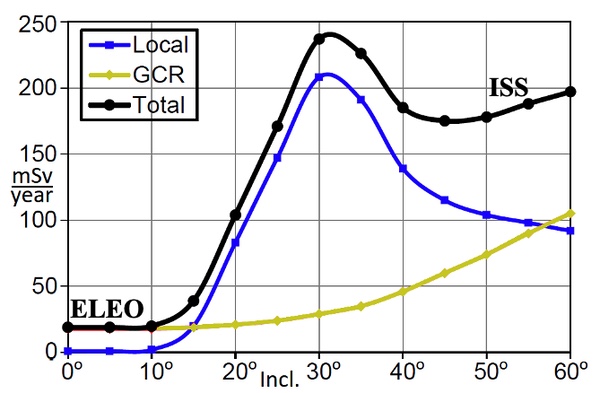 Figure 7. Radiation Dose vs Inclination at 400 kilometers |
The commercial cruise industry has around 180 years of experience in attracting tourists. Most current cruise ship capacity is based on approximately 40 cubic meters double-occupancy staterooms. Total enclosed ship volume is typically four to five times that. (“Gross tonnage” is the basis for port and other charges. It actually indicates not weight but enclosed ship volume, at ~3.1 cubic meters per ton for large ships.) Orbital tourists cannot easily go outside or take “shore trips,” so even more volume per person may be needed to appeal enough to tourists.
Most low gravity tourists may prefer stays long enough for resort costs to approach ride costs, perhaps one to three weeks. Some people may eventually want to retire in ELEO. They may also want to move inboard to lower gravity, as they get more frail over time.
| Low gravity may be popular, but healthy only in small doses, like sugar or salt. |
Cruise ship staff is usually 30–60% of passenger capacity. Most serve resort needs, not ship needs, and most serve ten-month contracts. [27] Some ELEO staff might serve far longer. This could generate invaluable health data on the sustained effects of Moon or Mars gravity versus age, gender, exercise, and other countermeasures. Some countries might even subsidize long-term staff costs to get such health data.
Early tourist facility and staff costs will be far higher than for cruise ships, but ride and resort prices will also be far higher. Cruise ship numbers for volume and staff per passenger may both be relevant. Smaller ratios may need some burden of proof.
To reduce costs, some ELEO operators may grow food and recycle a lot. Unlike many other space technologies like power and propulsion, farming, and recycling should have far more in common with similar tasks on Earth. But ELEO facilities may automate more thoroughly.
ELEO facilities always remain coplanar. Trips between them need only small amount of delta-v, and can use tether sling-and-catch ops. And even at 2,000 kilometers altitude, ELEO GCR doses are only half those at ISS. [25] And adding enough settlement mass to ELEO may even absorb most trapped protons, further reducing settlement shielding needs.
If we find that lunar gravity is enough for long-term health, humanity may expand to the six largest moons plus Mars and Mercury, and not just our Moon. If we need Mars gravity, we might settle Mars and Mercury, but not any moons. But even in 1g, exercise is critical. Any reduction in gravity is likely to require more exercise.
If we do need sustained gravity at levels higher than that of Mars, it seems easier to develop sustainable rotating settlements than to terraform any near-1g planet. And rotating settlements offer lower gravity inboard. A key attraction of such settlements may be the easy access to a wide range of gravity levels. What would Jackie Chan or X-Gamers do in low-g spaces?
Besides telling us how we might live in Moon or Mars gravity, rotating dumbbells can clarify the best spin rate, favorite gravity levels, design features, technologies, orbits, challenges, costs, and appeal of O’Neill-like colonies, in and beyond ELEO.
Misunderstanding health issues can be costly or lethal, for both people and programs. “The bends” drove the cost of the Brooklyn Bridge. [28] Mosquitos derailed the French Panama Canal program. [29] We did find fixes for each, but 20 to 30 years later.
| Moon-Mars dumbbells in LEO do not explore new places, but they can explore our future. |
Humans last walked on the Moon 49 years ago. Our futures in space may be further delayed or derailed until we find how and how well we can live in lower gravity. If “low gravity tourism” in ELEO becomes popular, long stays of tourism staff could show us the health implications of sustained partial gravity and countermeasures.
And instead of exploring just new places, we should also explore how to live far more sustainably, both on and beyond Earth. Mining extraterrestrial resources may usually require some site-specific tricks, but learning to “mine the midden” better should be useful anywhere, both on and beyond Earth. Dumbbell operators can usefully collaborate with many related sustainability projects on the ground.
Moon-Mars dumbbells can help us expand beyond Earth more effectively and sustainably, by identifying actual human constraints, so we can focus on realistic futures. Moon-Mars dumbbells have intrigued me for decades, but I did not grasp this until a few years ago.
Gravity is an analog parameter. Study of its effects on humans has treated it only as on/off, either zero or one. To learn what real futures we have beyond Earth, many people must live in sustained partial gravity, to find its effects on our health and wellbeing.
I want to thank Dave Brin, Henry Cate, John Charles, Mike Fennell, Al Globus, Ted Hall, Lynn Harper, Gary Hudson, Jim Logan, Gerald Nordley, John Oldson, and Dan Rasky for their ideas and feedback, and my wife for her patience.
Note: we are using a new commenting system, which may require you to create a new account.